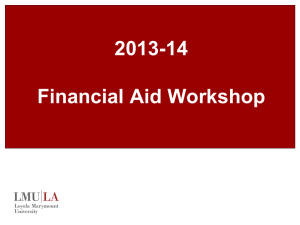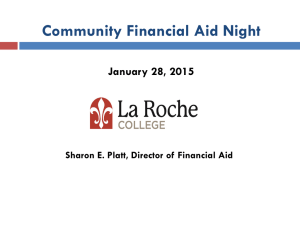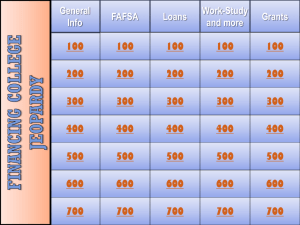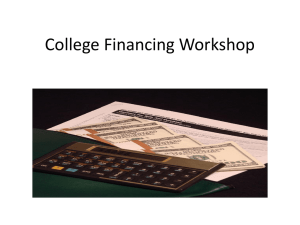Financial Aid - Caddo Mills ISD
advertisement
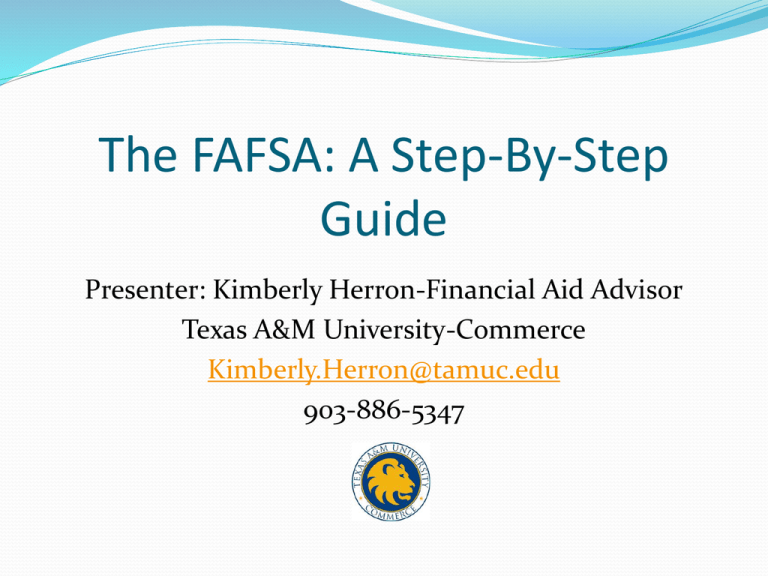
The FAFSA: A Step-By-Step Guide Presenter: Kimberly Herron-Financial Aid Advisor Texas A&M University-Commerce Kimberly.Herron@tamuc.edu 903-886-5347 The Financial Aid Application FAFSA What is the FAFSA? Before applying When to apply How to apply What to expect after applying Where to get help and info What Is the FAFSA? Free Application for Federal Student Aid Application for federal, state, institutional aid. Can be are requirement for scholarships. (e.g., Gates Millennium Scholarship) You are eligible to file a Free Application for Federal Student Aid (FAFSA) if you are: • • • • U.S. Citizen Permanent U.S. resident with a n Alien Registration Card (I-551) Conditional permanent U.S. resident with a visa type I-551 C Citizens of the Freely Associated Sate: the Federated States of Micronesia and the Republics of Palau and the Marshall Islands • Eligible noncitizen with an Arrival/Departure Record (I-94) showing one of the following • • • • Refugee Asylum granted, Parolee (for a minimum of one year),or Cuban-Haitian entrant Students who are not able to complete the FAFSA due to their immigration status may be able to file the Texas Application for State Financial Aid (TASFA). Texas Application for State Financial Aid (TASFA) Classified as a Texas resident Eligible to pay the Texas in-state tuition rate, not due to a waiver such as an in-state scholarship or assistantship. Available on line to print at www.collegeforalltexans.com. Please make sure you check the listings of the schools that accept the TASFA. If a school is not listed contact the Financial Aid office to see if they will accept the TASFA. This is a paper application and can not be submitted on-line so please send the application to each school you are applying to. Application should be completed and submitted as soon as possible after January 1st of the senior year. Priority deadline either the FAFSA or TASFA is March 15th! Whose Information goes on the FAFSA ? Independent vs. Dependent? • Student born before January 1, 1991? • As of they day the student completes the FAFSA they are married. • At the beginning of the 2014-2015 school year, the student will be • • • • • • • working on a master’s or doctoral program. Student is currently serving on active duty in the U.S. Armed Forces for purposes other than training. Student is a veteran of the U.S. Armed Forces. Student has children who will receives more than ½ of their support from the student. Student has legal dependents (other than their children or spouse) who live with them and receive more than ½ of their support from the student. At anytime since the student turned age 13, both parents were deceased, student was in foster care, or student was a dependent or ward of the court. Student is an emancipated minor. Student is in a legal guardianship. Independent vs. Dependent Continued… • At any time on or after July 1, 2014, did the students high school or district homeless liaison determine that the student was unaccompanied youth who was homeless? • At any time on or after July 1, 2014, did the director of an emergency shelter or transitional housing program funded by the U.S. Department of Housing and Urban Development determine that the student was an unaccompanied youth who was homeless. • At any time on or after July 1, 2014, did the director of a runaway or homeless youth basic center or transitional living program determine that the student was an unaccompanied youth who was homeless or self-supporting and/or at risk of being homeless. Parent Information on the FAFSA • Even if the student does not live with the parent(s) the parent(s) • • • • • • information must be used to complete the FAFSA. Grandparents, foster parents, legal guardians, aunts and uncles are not considered parents unless they have legally adopted the student. If parents are living and married to each other include both. If parent is widowed or single answer the questions about that parent. If widowed parent is remarried as of they day the FAFSA is completed, answer the questions about that parent and stepparent. If parents are divorced or separated, answer the question about the parent the student lived with the last 12 months. If the student did not live with one parent more than the other, give answers about the parent who provided more financial support during the past 12 months. Students unable to provide parental information on the FAFSA Under very limited circumstances (for example, student has left home due to an abusive family environment; or student does not know where their parents are and are unable to contact them), student will submit the FAFSA without parental information. The student will skip Parental Information. If the student submits the FAFSA without parental data, they must follow up with the financial aid office at the college they plan to attend in order to complete the FAFSA. Before Applying Get a PIN-this acts as a signature and is attached to a social security number. Student needs a PIN Parent needs PIN also www.pin.ed.gov or at www.fafsa.gov Student must keep it PRIVATE Complete your taxes! Remember the PIN is linked to your Social Security Number so when you apply for your PIN please enter your name as it appears on your Social Security Card. When to Apply ? Each school sets their own FAFSA Priority Deadline Dates! So make sure you check with the institutions you plan on applying to. If you are attending a school in the State of Texas you will want to file a FAFSA no later than March 15th! How to Apply ? Application Methods Paper FAFSA – NOT recommended due to length of processing time. Download PDF at www.fafsa.gov and print out. Quickest and easiest: FAFSA on the Web at www.fafsa.gov You may also need to apply through the college as well. (Private and out of State Institutions may have another Institutional Financial Aid application). FAFSA on the Web FAFSA on the Web FAFSA on the Web Login Using the Students PIN FAFSA on the Web Select Start a New FAFSA FAFSA on the Web Introduction Page FAFSA on the Web Questions to expect Citizenship Marital Status State and date of legal residence Selective Service Registration Drug Convictions Educational Background Plans for 2014-2015 school year (on campus/off campus) Tax information Cash, savings, checking Investments Net worth of business and investment farms Number in household Number in College Parent has a current default on a loan student will be unable to receive a loan. 2014-15 IRS Data Retrieval Available February 5, 2014 for 2014-2015 FAFSAs Can file FAFSA earlier using estimated information. If estimated information is used make sure to go back when taxes are completed and make a correction, use the Data Retrieval Tool to link the tax information into the FASFA and resubmit. Links the parents/students tax income into the FASFA. Allow 2 weeks if taxes e-filed. Allow 8 weeks if taxes done on paper. IRS Data Retrieval IRS Data Retrieval Sign and Submit the FAFSA Student and Parent use PINs to sign. Read and save/print confirmation page. What to Expect After Applying Hearing from Department of Education An email will be sent after the FSAFA is completed this does not mean that the schools you have put on the FAFSA has the information just yet. To check status: Student returns to www.fafsa.gov and logs in. Student receives notice of Student Aid Report within about 3 days Student Aid Report summarizes student’s responses Can make corrections on FAFSA on the Web Student Aid Report shows Expected Family Contribution (EFC). The EFC is used by the Financial Aid Office to determine need based aid eligibility. Verification Some students selected based on common mistakes Some students selected randomly School will ask for documents such as: Tax Return Transcripts (copies of the actual tax return are no longer acceptable). Can be requested at www.irs.gov or call 1-866-704-7388. W2’s or 1099’s Divorce Decree Legal Guardianship Proof of child support paid Copy of birth certificates Passports Social Security Proof of registration with Selective Service males 18-25 MEET SCHOOL’S DEADLINE FOR THE DOCUMENTATION REQUEST! Awards can not be processed unless the additional documentation is received in most cases. Budget your college costs Don’t forget that actual expenses will vary based on your lifestyle. Use a budget calculator to estimate your actual expenses. College Net Price Calculator www.collegeforalltexans.com Financial Aid Options Scholarships Grants Work-Study Loans Apply for scholarships-free money! Scholarships are a type of “gift aid” and do not require repayment. You should always find out if you are eligible for any gift aid before you consider borrowing money. Note: You generally do not have to complete a FAFSA for scholarship eligibility consideration, but it’s still a good idea. Scholarships may or may not be partly based on financial need. Scholarships require some digging Check with your high school counselor. Check with your college financial aid office. Visit the local library. Ask local businesses and organizations. Use online scholarship searches. Scholarships are for all kinds of students Scholarship eligibility may be primarily based on one or more of the following factors: Academic performance Athletics A particular field of study Ethnic background Religious affiliation Special interests Grants: Gift Aid Like scholarships, grants are a type of gift-aid and do not require repayment. Unlike scholarships, grants are based primarily on your financial need (attached to the EFC). Types of Federal grants Federal Pell Grant Federal Supplemental Educational Opportunity Grant (SEOG) Teacher Education Assistance for College and Higher Education (TEACH) Grant Other types of grants State grants Visit the College for All Texans Web site to see what grants are available in your state at www.collegeforalltexans.com Private and institutional grants Grants may be available through the school you attend or other sources, such as alumni associations and corporate sponsorships. Work-Study Program The Federal Work-Study (FWS) or Texas Work-Study (TCWS) program provides part-time jobs for undergraduate and graduate students with financial need, allowing them to earn money to help pay educational expenses. Types of FWS/TWS jobs The program encourages work that provides service to the community and work related to the recipient’s course of study. A FWS job could be one of the following: • • • • Clerical position Computer lab proctor Museum guide Childcare worker • • • • Lab research assistant Library assistant Food server Usher at public events Did You Know? More than half of undergraduate students cannot afford to pay for college without incurring some form of debt. STOP! A student loan is not free money. Unlike a scholarship or grant, a student loan is a financial obligation that won’t go away until it is paid in full. Borrow only the amount you absolutely need to cover your expenses. Think about how you’ll pay back your loan before you borrow anything. Stafford Loans Stafford loans are low-interest student loans, borrowed from lenders, available to undergraduate and graduate students who are enrolled at least half time. Stafford: Subsidized vs. Unsubsidized Subsidized Unsubsidized Need-based Non-need-based Interest: Interest: Government pays during Student responsible for paying in-school, grace, and deferment periods Student pays during repayment Current Rate 3.86% Cap 8.25% Can be capitalized during in- school, grace, and deferment periods, or Student can choose to pay interest during those periods. Current Rate 3.86% Cap 8.25% Stafford: annual loan limits for dependent students Stafford: annual loan limits for independent students Stafford: Lifetime (aggregate) loan limits PLUS loans PLUS loans are federal loans, borrowed from lenders, that allow a parent of a dependent undergraduate student or a graduate student to borrow funds to help meet educational expenses. PLUS loans should supplement the loans borrowed under the Federal Stafford Loan Program. Borrowers must pass a credit check or have a creditworthy endorser. Annual loan limit is your cost of attendance, minus any other financial aid. Application is online at www.studentloans.gov parent will login using their FAFSA PIN number. Current interest rate 6.41% Hearing from the School: The Award Letter Offer of aid (Federal + State + School) Let school know about private scholarships or other outside aid This could impact award COA – EFC = need Student can not receive aid over the COA Respond to school promptly Award will typically be issued through the institutions student portal system or by mail. What is Cost of Attendance (COA) The amount it will cost a student to attend an institution during a period of enrollment. Direct Costs Billed by or paid directly to the college, such as tuition and on campus housing and meal plans. Indirect Costs Necessary expenses, such as transportation and personal care items that are not paid to the college. College combine direct and indirect expenses into the cost of attendance, or student budget. Varies widely from college to college. Private vs. State, In State vs. Out of State Cost of Attendance Example Understanding the Financial Aid Award Letter University of XYZ COA=$19,500 Students EFC= $0 Financial Aid Award Example: Award Fall Spring Total Pell Grant $2,775 $2,775 $5,550 Freshman Scholarship $500 $500 $1,000 Stafford Subsidized $1,750 $1,750 $3,500 Stafford Unsubsidized $1,000 $1,000 $2,000 Parent PLUS $3,225 $3,225 $6,450 Total $9,250 $9,250 $19,500 Financial Aid Award Example: Award Fall Spring Total Pell Grant $2,775 $2,775 $5,550 Freshman Scholarship $500 $500 $1,000 Stafford Subsidized $1,750 $1,750 $3,500 Stafford Unsubsidized $1,000 $1,000 $2,000 Parent PLUS $3,225 $3,225 $6,450 Total $9,250 $9,250 LETS ANALYSIE COA= $19,500 EFC= $0 Students Financial Need= $19,500 Students FA Award w/o PLUS= $13,050 Family’s Possible Out of Pocket Expense=$6,450 $19,500 UNDERGRADUATE FULL-TIME STUDENTS (15 hrs) 10/11 FALL/SPRING BUDGET Undergraduate Resident On Campus TUITION AND FEES ROOM AND BOARD Undergraduate Resident At Home $7,505 $7,505 $7,232 $2,700 BOOKS AND SUPPLIES $1,400 $1,400 TRANSPORTATION MISC./PERSONAL EXPENSES $1,500 $1,545 $1,867 $1,867 TOTAL $19,500 $15,017 Lets just look at Direct Costs: Tuition and Fees= $7,505 Room and Board= $7,232 Total Direct Cost= $14,737 -Students FA Award= $13,050 Out of Pocket= $1,687.00 Would the Parent Need to take a Parent PLUS out for $6,450? Where to get Help and Information FAFSA Help: Live chat option at www.fafsa.gov or call 1-800-4FEDAID Net Price Calculator, Waivers, Rebates, State Aid, State College comparisons, TASFA: www.collegeforalltexans.com IRS www.irs.gov or call 1-866-704-7388 Parent PLUS Loan Stafford Loan Information: www.studentloans.gov Department of Education: www.studentaid.gov State Loan Options: www.hhloans.com Kimberly Herron-Financial Aid Advisor Texas A&M University-Commerce Kimberly.Herron@tamuc.edu 903-886-5347
